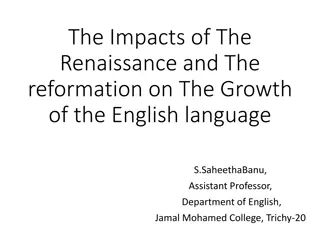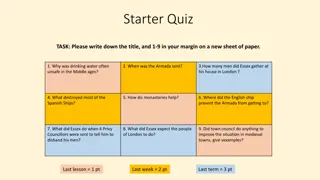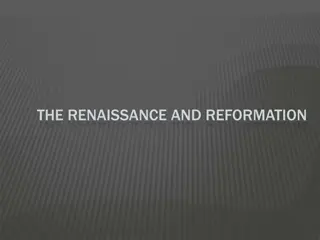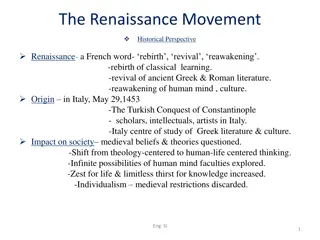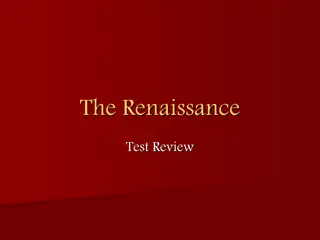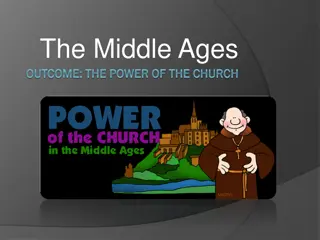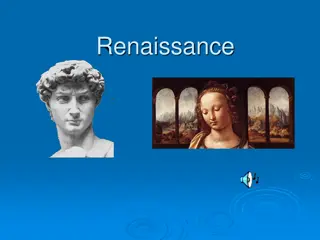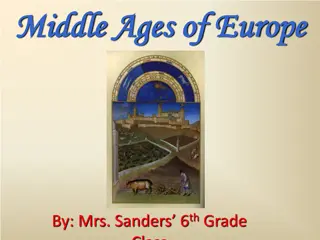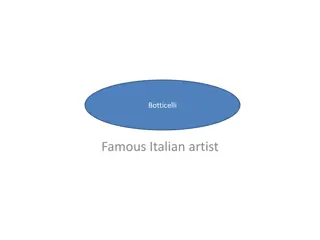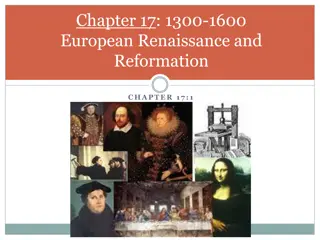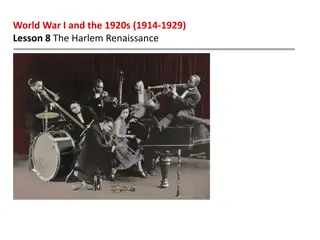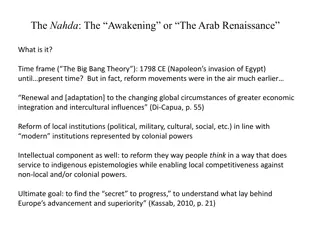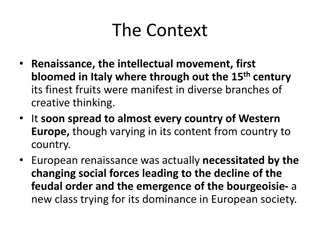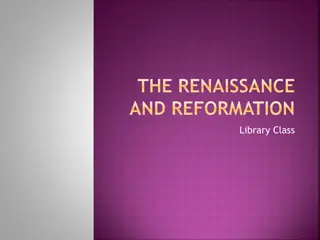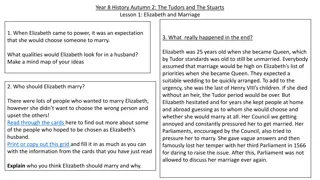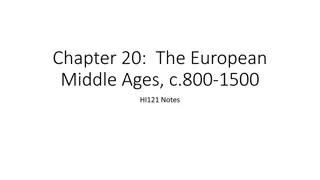Evolution of European Culture from the Middle Ages to the Renaissance
Explore the transformation of European culture from the Middle Ages to the Renaissance, delving into aspects such as medieval culture, the impact of crises, historical landmarks like Notre Dame and Westminster Abbey, the rise of cities and the middle class, and the influence of prominent figures like Thomas More and Desiderius Erasmus.
Download Presentation

Please find below an Image/Link to download the presentation.
The content on the website is provided AS IS for your information and personal use only. It may not be sold, licensed, or shared on other websites without obtaining consent from the author. Download presentation by click this link. If you encounter any issues during the download, it is possible that the publisher has removed the file from their server.
E N D
Presentation Transcript
The Middle Ages and the Renaissance The Rise of European Culture
Medieval Culture Ignorance Life Expectancy Pagan vs. Christian Feudalism Poor Economy Vague Nationalities United by Church Poor Bureaucracies Art
Crises of the Middle Ages Crusades Hundred Year s War Great Schism The Black Plague
Video About the Middle Ages http://www.youtube.com/watch?v=fr8DIg3oHFI
Spread of European Universities
Thomas More Image:Hans Holbein d. J. 065.jpg I think putting thieves to death is not lawful; and it is plain and obvious that it is absurd and of ill consequence to the commonwealth that a thief and a murderer should be equally punished. - Utopia
Desiderius Erasmus Piety requires that we should sometimes conceal truth Perhaps we must admit with Plato that lies are useful to the people. Desiderius Erasmus in 1523 as depicted by Hans Holbein the Younger What? asks Peter [gatekeeper of heaven], astounded, Popes with wives and children? Pope Julius II, equally surprised replies, No, not wives, but why not children? -In Praise of Folly
Rise of Cities Cities built up along crusader routes. They also grew more powerful after the plague, because plague forced cities to organize. Also, after the plague many peasants moved to the cities and found that if they were talented they could get well- paying jobs previously held by plague victims. Vienna LyonsGenoa
Rise of the Middle Class The Renaissance and the Reformation were not mass movements. They were led by the newly literate middle and upper classes. The middle class rose thanks to an increase in wealth. Most of them were not fluent, but had been taught pidgin Latin by a lower level clergy, encouraged by parents who realized that education was the future
The Rise of the Super Rich A new entrepreneurial class was emerging in the wake of the plague. These people were often low-level nobility, or even peasants, who figured out how to make money in the new, growing economy. These families managed to accumulate the kind of wealth that was necessary to finance intellectual growth.
National Unification Nations began to unify during this era. In France, people began to see themselves not as Normans or Parisians, but as Frenchmen. These newly united nations often rallied around symbols and mythic figures, like Joan of Arc.
Classicism Instead of painting religious figures for the church, Renaissance artists were often commissioned to paint secular images for commission. This is called the Birth of Venus, by Botticelli. It was painted for Lorenzo de Medici, a wealthy Florentine duke. Venus was the Roman goddess of love and beauty.
Humanism This sculpture by Michelangelo, David, glorifies man, not God. Even though David was an ancient Hebrew king, this sculpture has nothing to do with the religious overtones of his story. Instead, it glorifies the human body. The Renaissance was a time when Europeans were starting to realize that the humanity was not condemned to wallow in sin, but it could be great. This sculpture highlights the proud, optimistic culture of the Renaissance.
The Prince by Niccolo Machiavelli Image:Macchiavelli01.jpg The Prince describes what Machiavelli thinks are qualities that a prince, or leader would need to be effective. Instead of championing piety and sacrifice, Machiavelli wrote truthfully that a good leader must be ruthless and conniving to rule effectively "It is best to be both feared and loved; however, if one cannot be both it is better to be feared than loved. War is not to be avoided, but is only to be put off to the advantage of others.
Da Vinci Leonardo Da Vinci was a true Renaissance man. He was a brilliant engineer, painter and scientist. He is most famous for his painting skills. Above is The Last Supper and The Mona Lisa. Notice the use of perspective, the personality of the figures painted, and the rich use of color. Also notice the development of spacial relations. Da Vinci carefully organizes the design of the room and the position of the apostles so that the viewers eyes are immediately drawn to Jesus.
Michelangelo The iconic image of the Hand of God giving life to Adam. The ceiling of the Sistine Chapel


![READ⚡[PDF]✔ European Mail Armour: Ringed Battle Shirts from the Iron Age, Roman](/thumb/20552/read-pdf-european-mail-armour-ringed-battle-shirts-from-the-iron-age-roman.jpg)
